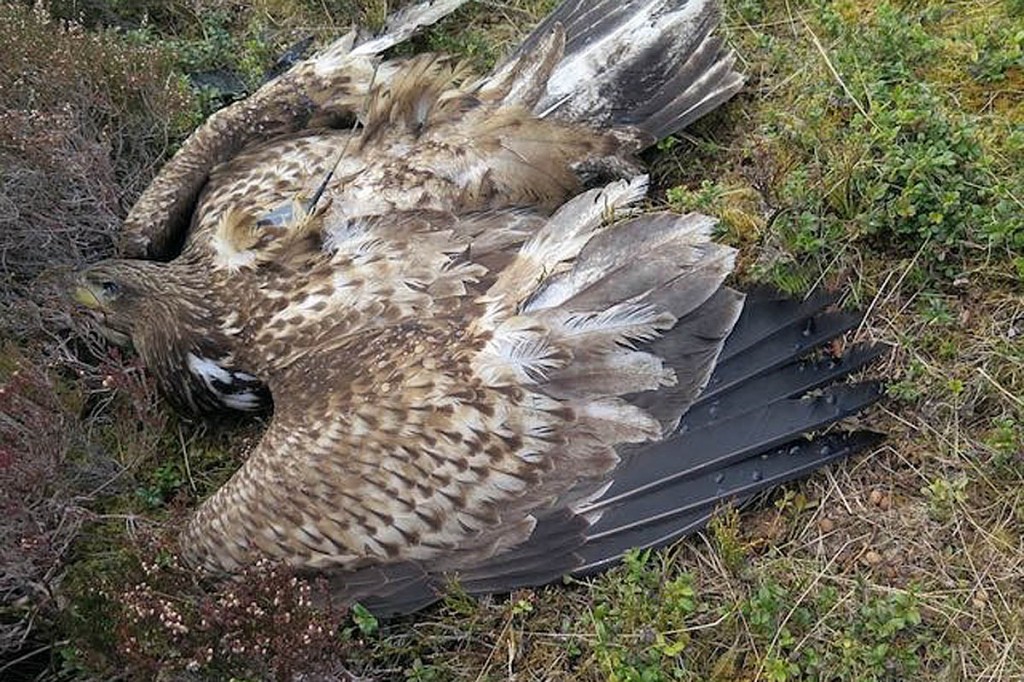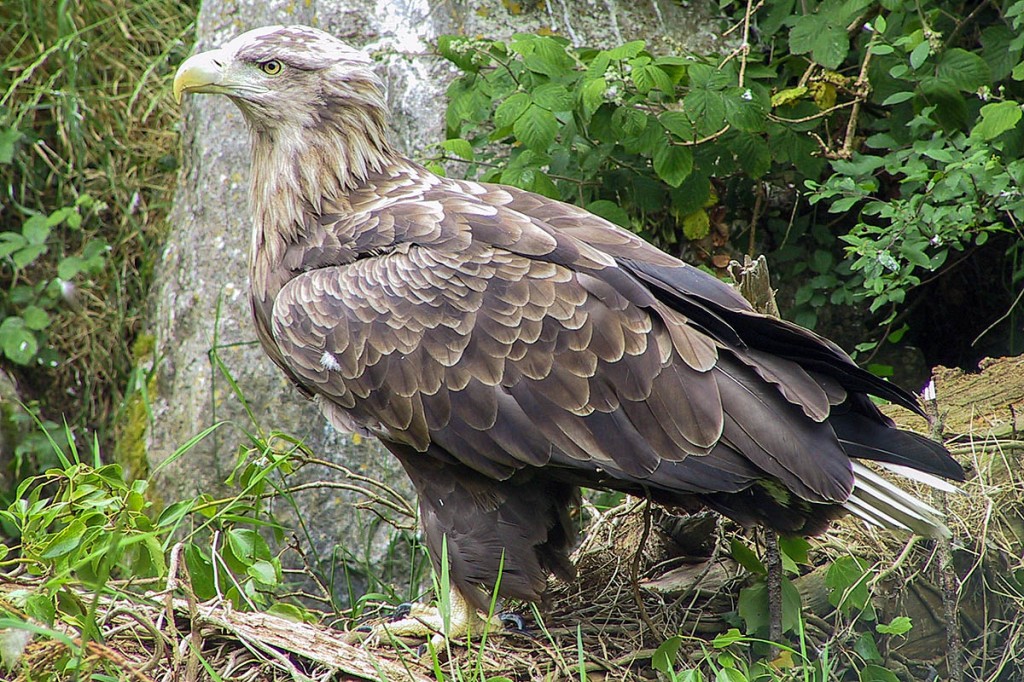A rare bird of prey whose body was found in the Cairngorms national park was poisoned, police said.
The dead white-tailed sea eagle was found in Strathdon in the East of the national park in April.
The one-year-old was satellite tagged and the Royal Society for the Protection of Birds Scotland informed police when it was clear the bird was no longer moving.
A post-mortem examination revealed the eagle had been poisoned, and Police Scotland said its death is being treated as suspicious. Officers appealed to anyone with information that might help identify the criminal responsible to contact them.
They said an investigation is continuing.
White-tailed sea eagles were re-introduced into Scotland in the 1970s after becoming extinct in the UK in the early 1900s. There are now over 150 breeding pairs in Scotland. The bird found in April in Aberdeenshire fledged from the first successful nest of a white-tailed eagle that was wild-bred, and marked a major step forward in the re-establishment of the species in the East of the country, RSPB Scotland said.
Police Inspector Sheila McDerment, who chairs the North East Partnership Against Wildlife Crime, said: “As well as being illegal, poisoning is a cruel way to kill a bird. It also puts the lives of other creatures and plants at risk and impacts negatively on our environment.
“This incident is particularly upsetting because these rare and beautiful birds had been re-introduced to Scotland after being extinct throughout the UK.
“Raptor persecution is one of six priorities set by the UK National Wildlife Crime Unit. In the North-East we work closely with a number of partners to tackle wildlife crime. Members of the public are our eyes and ears. I appeal to anyone out there who may hold any information about this incident to help us bring the offender to justice by coming forward and telling us what they know.”
Ian Thomson, RSPB Scotland’s head of investigations said: “The news that this bird has been illegally poisoned is appalling.
“This crime would never have come to light had the bird not been fitted with a satellite tag, and the killing of this young eagle can be added to a litany of raptor persecution incidents in recent years, including previous poisonings and multiple disappearances of similarly tagged birds of prey.
“Poisoning is vicious and indiscriminate and we join with Police Scotland in appealing for information.”
Detective Chief Superintendent Gary Cunningham, wildlife crime lead for Police Scotland, said: “Scotland’s rich, rare and diverse wildlife and landscapes are among its biggest attractions. We cannot allow the indiscriminate use of poisons and pesticides to threaten our natural heritage.
“Police Scotland, working with our key partners, is committed to protecting our wildlife habitats and to bringing those who seek to destroy or harm it, to justice.”
Mr Thomson said: “Today’s appalling news that a white-tailed eagle has been illegally killed on a grouse moor in the Strathdon area of Aberdeenshire won’t come as a particular surprise to any of us who have been involved in the conservation of Scotland’s birds of prey over the last 15 or so years.
“It was killed in early April, during the early days of strict Covid-19 lockdown when our countryside was, in effect, closed to all but local people and those still working in the countryside.
“This young eagle is the latest victim of a widespread, relentless and systematic campaign of shameful persecution of raptors in this area, dominated by intensive driven grouse moor management, dating back over many years.
“Recent confirmed crimes here have included the shooting of a goshawk, the targeted destruction of a goshawk nest in a nearby publicly owned forestry plantation; and the disappearance of two satellite-tagged hen harriers, including one in April this year.”
He said there were multiple cases of suspicious disappearances of satellite-tagged golden eagles in upper Donside.
“In April 2014, the first young white-tailed eagle to fledge from a nest in the East of Scotland in one hundred years also suddenly disappeared here.
“A satellite-tagged golden eagle was found poisoned in Glenbuchat in 2011. The national golden eagle survey 2015 showed that less than a third of known golden eagle home ranges in the eastern Cairngorms were occupied despite the fact that this area should be the most productive for this species in Scotland given the widespread availability of red grouse and mountain hare prey. Illegal killing was identified as the main threat.
“We all hoped the dark days of poisoned raptor cases were fading into the past. The use of such chemicals is not just illegal, it is pre-meditated and indiscriminate – whatever the intentions of the criminal who places out a bait.
“So, the news we received in the last few days that this young white-tailed eagle had been the victim of poisoning by an illegal pesticide is both exceedingly depressing and deeply worrying. It is perhaps all the more so because this bird was of a new generation of white-tailed eagles originating from the East of Scotland re-introduction supported by Scottish Government that began in 2007.”
Police Scotland said anyone with information can contact them on 101 quoting crime reference number CF0160960720. The public can also report information anonymously by contacting Crimestoppers on 0800 555 111.


Outdoor Enthusiast
27 July 2020Appalling. If this was motivated by a desire to protect livestock then the need to do so should be brought to the attention of the relevant agencies and accommodations made to protect both the bird of prey and livestock. If the killing was motivated by over-zealous protection of shooting stock and their environment (cf: recent reports of poisoned birds of prey in N Yorks) then unethical practices within the commercial shooting industry should be properly investigated and potentially barred as an acceptable 'sport' in the 21st century.
Ben Avon
27 July 2020This is so sad. In terms of the Cairngorms it's one of the same two areas over and over again, either Strathdon or the Angus Glens. There needs to be a particular focus upon what the sporting estates are up to in the eastern Cairngorm's.
jenny brown
29 July 2020Outrageous!! To think that in this day an age wildlife is persecuted in the name of protecting "game" birds, simply so that they can be shot for fun is absolutely disgusting. Nobody has ever been convicted of killing an eagle in Scotland before so I won't hold my breath for this one. Ban all bloodsports.
Jennifer White
29 July 2020While shooting remains a lucrative commercial enterprise and can be 'defended' as providing local employment, it is unlikely to be challenged in the way fox hunting was. The latter continues, despite being supposedly an illegal activity. I have personally seen two senior hunt members drive a fox out of cover, to be chased by two hounds (again, justifiable as legal as the intention was to eradicate vermin - my expletives deleted). Then a local farmer on a quad bike drove directly towards the fox to prevent it going under cover. Just around the corner was the hunt's 4-wheel drive vehicle with a member of the hunt waiting to shoot the fox, should it survive the hound onslaught. On that occasion the fox made it into the ditch and ran across my path into the next field. I was then spotted and the hounds were called off. I was sickened by the experience and have since also had vociferous arguments with our local gamekeeper over the threatening practices aimed at dog walkers when the pheasants have been released prior to the start of the shooting season. I have been harassed, verbally abused and my dogs filmed by the gamekeeper as a warning and threatened with further action for walking my two dogs along public footpaths which border pheasant woods and cover. As a country living person all my life, the arrogance of those who have vested interests in preserving these indefensible and cruel practices knows no bounds. I have also encountered a recently shot small bird of prey in our local woods - tragic.
Lynne Webb
09 August 2020If the hunting estates and gamekeepers are serious about protecting wildlife they should have to sign up to a good practice policy with Rspb, RSPCA, and other wildlife agencies. This should include the agencies overseeing, inspecting the land, checking the poison substance account that must be available under the poisons act. The land owner must encourage the agencies to visit the estates on a regular basis. The responsible governments must be prepared to pay estates to protect raptors, to tax any profits made from grouse shooting events, to tax individuals who take part. This revenue would be ring fenced for raptor and wildlife conservation.
The hope is to make the grouse shoot unprofitable, to end the cruel sport, to encourage people to pay as much money to protect, conserve and enjoy watching the local raptors and wildlife as they do to kill them.
Night Heron
14 December 2020WHO EVER IS DOING THIS NEEDS TO BE ARRESTED AND CHARGED FINED AND JAILED FOR 25 YEARS